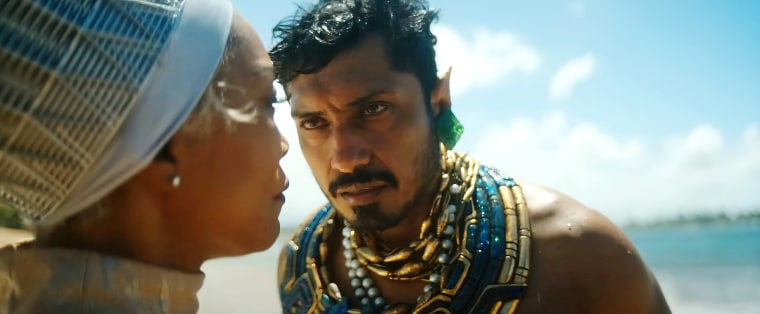A stunning tribute to the late Chadwick Boseman, “Black Panther: Wakanda Forever,” begins with the death of his character, T’Challa. Desperate to save her brother from the illness that has consumed him, a frantic Shuri (Letitia Wright) flits around her science lab, attempting to unearth the antidote that might save the Wakandan king. Tragically, her efforts are fruitless. Before the opening credits roll on the film, a despondent Queen Ramonda (Angela Bassett) tells her last living child, “Your brother is with the ancestors.”
The real-world trauma of Boseman’s shocking death from colon cancer in August 2020 collides with the aftermath of his character’s passing in “Wakanda Forever.” It’s an action-packed film full of grief, rage and the towering burden of legacy. His spirit stands at the film’s center as director Ryan Coogler examines why rage and trauma can be both a determinant and a pillar to communities of color.
The real-world trauma of Boseman’s shocking death from colon cancer in August 2020 collides with the aftermath of his character’s passing in “Wakanda Forever.”
Marvel Cinematic Universe fans and those who’ve seen the first “Black Panther” know that Wakanda has thrived for centuries due to its isolationist policies. Unlike other countries rich with resources, the fictional West African country has stayed out of global affairs, effectively shielding itself from colonialist poachers who would surely burn the world to get their hands on Wakandan vibranium — the world’s strongest metal. But during his reign, T’Challa began to consider sharing vibranium with the outside world, especially if it meant empowering Black people across the globe.
In “Wakanda Forever,” it’s clear that Ramonda is not interested in pursuing her late son’s “new age” policies, but that hasn’t stopped the Western world from desperately seeking out vibranium by any means necessary. Their greed introduces viewers to the Talokans, an Indigenous people who have lived underwater using vibranium as their most potent resource since their Mayan Empire was pillaged and brutalized by outsiders, leading to the enslavement and genocide of their people.
Unlike T’Challa, and much more in line with his father, King T’Chaka, the Talokan’s ancient ruler Namor (Tenoch Huerta Mejia), is fueled by the rage of past traumas. He remembers all too well the atrocities of the surface world. He will stop at nothing — even obliterating Wakanda —- to protect and preserve the majesty and secrets of the Talokanil civilization’s underwater dwellings so that they may never be vulnerable to others again.
Rage is often called a wasted emotion, something to be shamed or ignored. However, as the acclaimed writer and poet Audre Lorde said in her 1981 keynote presentation at the National Women’s Studies Association Conference, anger — and therefore rage — are “potentially useful against those oppressions, personal and institutional, which brought that anger into being.” Namor’s anger has kept his people safe. Still, it begins to morph into something much more sinister when he puts a bounty on the head of young MIT scientist Riri Williams (Dominique Thorne). The 19-year-old unknowingly created the vibranium tracker that led the CIA into the Talokans’ hidden territory, putting it in grave danger.
While the trauma of the Talokans has bonded them together as a people, Shuri’s grief and rage have fueled self-isolation. Resigned to work, she lashes out at anyone who tries to embrace her — including her mother. Shuri also dismisses the Black Panther as a relic of the past. After all, the strength of Wakanda’s protector failed to protect her brother from death.
It symbolizes the type of distraction that marginalized communities too often succumb to, one that stops them from propelling their individual and mutual causes forward.
Yet, as much as Namor’s rage and trauma mirror her own, even Shuri cannot condone Riri’s murder, even if her death would mean keeping both Wakanda and Talokan safe forever. The Wakandan princess’s choice to save Riri with the help of Nakia (Lupita Nyong’o) enrages Namor. It sets off a war between the Wakandans and the Talokanil people, who should have been the closest allies.
It symbolizes the type of distraction that marginalized communities too often succumb to, one that stops them from propelling their individual and mutual causes forward. It’s a staple of white supremacy that enables oppressors to remain in power.
T’Challa’s death and Shuri’s anguished-filled reaction to the devastating loss, among others, are the catalysts upon which “Black Panther: Wakanda Forever” hinges. It all comes to a head on a massive Afrofuturistic Wakandan ship, where the Wakandans and Talokans nearly implode on one another.
The climatic sequence becomes a literal representation of what Paulo Freire described in “Pedagogy of the Oppressed” as “the oppressed, instead of striving for liberation, tend themselves to become oppressors.” Rather than focusing their efforts on their actual adversaries, they become distracted enough to rip each other down.
“Black Panther: Wakanda Forever” doesn’t ask Shuri, Namor or the audience to push past their anger and grief — it’s a constant in this film. Instead, the sequel examines what it would mean for all that rage and suffering to transform into something that might save us all.

